
An oil refinery or petroleum refinery is an industrial process plant where petroleum is transformed and refined into useful products such as gasoline (petrol), diesel fuel, asphalt base, fuel oils, heating oil, kerosene, liquefied petroleum gas and petroleum naphtha. Petrochemicals feedstock like ethylene and propylene can also be produced directly by cracking crude oil without the need of using refined products of crude oil such as naphtha. The crude oil feedstock has typically been processed by an oil production plant. There is usually an oil depot at or near an oil refinery for the storage of incoming crude oil feedstock as well as bulk liquid products. In 2020, the total capacity of global refineries for crude oil was about 101.2 million barrels per day.
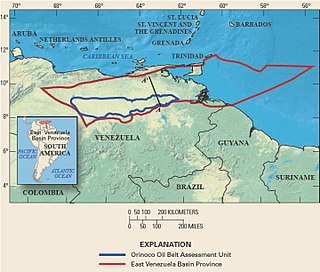
The Orinoco Belt is a territory in the southern strip of the eastern Orinoco River Basin in Venezuela which overlies the world's largest deposits of petroleum. Its local Spanish name is Faja Petrolífera del Orinoco.

National Iranian Oil Refining and Distribution Company (NIORDC) is part of the Ministry of Petroleum of Iran. NIORDC was established on 8 March 1991 and undertook to perform all operations relating to refining and distribution of oil products.

Ecopetrol, formerly known as Empresa Colombiana de Petróleos S.A. is the largest and primary petroleum company in Colombia. As a result of its continuous growth, Ecopetrol forms part of the Fortune Global 500 and was ranked 346. In the 2020 Forbes Global 2000, Ecopetrol was ranked as the 313th -largest public company in the world. It was ranked 303 in 2012 by CNN Money. The company belongs to the group of 25 largest petroleum companies in the world, and it is one of the four principal petroleum companies in Latin America.
The Ras Lanuf Refinery is a topping and reforming oil refinery in Ras Lanuf, Libya. It is part of a larger petrochemical complex also consisting of an ethylene plant, a polyethylene plant, plant utilities, and Ra's Lanuf Harbor. Until 9 March 2009, the complex was operated by the RASCO, a subsidiary of the National Oil Corporation. The current operator is the Libyan Emirates Oil Refining Company.
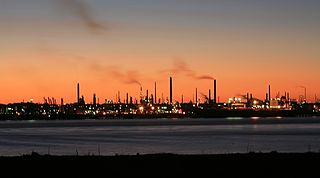
Fawley Refinery is an oil refinery located at Fawley, Hampshire, England. The refinery is owned by Esso Petroleum Company Limited, a subsidiary of Exxon Mobil Corporation, which acquired the site in 1925. Situated on Southampton Water, it was rebuilt and extended in 1951 and is now the largest oil refinery in the United Kingdom, and one of the most complex refineries in Europe. With a capacity of 270,000 barrels (43,000 m3) per day, Fawley provides 20 percent of the UK's refinery capacity. An estimated 1000 people are employed at the site.
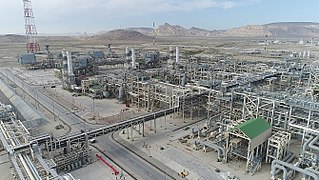
The Sangachal Terminal is an industrial complex consisting of a natural gas processing plant and oil production plant, located on the coast of the Caspian Sea 45 kilometres (28 mi) south of Baku, Azerbaijan.

The Transandino pipeline is a 305-kilometre (190 mi) long crude oil pipeline, which transports oil from Orito, in the Department of Putumayo, to the Pacific port of Tumaco in the Department of Nariño, Colombia. The pipeline was built in 1969 with diameters of 10 inches (250 mm), 14 inches (360 mm) and 18 inches (460 mm). There are four pump stations and four reduce pressure stations. The pipeline has the capacity of 190,000 barrels per day (30,000 m3/d). It is operated by Ecopetrol.

The Chevron Richmond Refinery is a 2,900-acre (1,200 ha) petroleum refinery in Richmond, California, on San Francisco Bay. It is owned and operated by Chevron Corporation and employs more than 1,200 workers, making it the city's largest employer. The refinery processes approximately 240,000 barrels (38,000 m3) of crude oil a day in the manufacture of petroleum products and other chemicals. The refinery's primary products are motor gasoline, jet fuel, diesel fuel and lubricants.
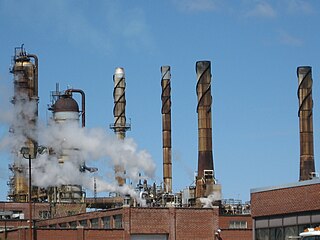
The Montreal East Refinery was an oil refinery located in Montreal East and formerly Shell Canada's largest refinery. In October 2010, refinery operations permanently ceased and the facility was subsequently converted into a storage terminal.

The Paraguaná Refinery Complex is a crude oil refinery complex in Venezuela. It is considered the world's third largest refinery complex, just after Jamnagar Refinery (India) and Ulsan Refinery. The Paraguaná Refinery Complex was created by the fusion of Amuay Refinery, Bajo Grande Refinery and Cardón Refinery. The Paraguana Refinery Complex is still the largest refinery in the Western Hemisphere. As of 2012, it refined 955 thousand barrels per day (151,800 m3/d). The complex is located in the Paraguaná Peninsula in Falcón state and the western coast of Lake Maracaibo in the Zulia state. The complex accounts for 71% of the refining capacity of Venezuela and it belongs to the state-owned company Petróleos de Venezuela (PDVSA).

The Ocensa pipeline is a crude oil pipeline in Colombia. It starts on the Cusiana and Cupiagua oilfields and runs to Coveñas on Colombia's Caribbean coastline. It is owned by the consortium of Ecopetrol, BP, Total S.A., Petrominerales and Triton Colombia.

The Clyde Refinery was a crude oil refinery located in Clyde, New South Wales, Australia, operating between 1925 and 2013. At the time of its closure it had a refinery capacity of 85,000 barrels per day (13,500 m3/d) and was the oldest operating oil refinery in Australia. It was operated by Shell Refining (Australia) Pty Ltd and owned by the Royal Dutch Shell.

The Tema Oil Refinery (TOR) is one of two crude oil refineries in Ghana.

The Bahrain Petroleum Company (BAPCO) is an integrated national oil company of Bahrain.
The petroleum industry in Colombia is an important contributor to the country's economy.
The Iranian Central Oil Fields Company established in 1999, is one of the five major production companies of the National Iranian Oil Company. It is responsible for production of gas and oil from 76 reservoirs, comprising 45 gas fields and 31 oilfields; among them, 14 gas fields and 13 oilfields are currently in operation, and by the end of the 20 year outlook plan it will have reached 89 fields in 19 provinces. The Company, at its establishment, was assigned to develop and to produce oil and gas from onshore fields through utilization of all available technology and know-how. As of 2015, ICOFC is the largest natural gas producer in Iran.
Western Canadian Select (WCS) is a heavy sour blend of crude oil that is one of North America's largest heavy crude oil streams and, historically, its cheapest. It was established in December 2004 as a new heavy oil stream by EnCana, Canadian Natural Resources, Petro-Canada and Talisman Energy. It is composed mostly of bitumen blended with sweet synthetic and condensate diluents and 21 existing streams of both conventional and unconventional Alberta heavy crude oils at the large Husky Midstream General Partnership terminal in Hardisty, Alberta. Western Canadian Select—the benchmark for heavy, acidic crudes—is one of many petroleum products from the Western Canadian Sedimentary Basin oil sands. Calgary-based Husky Energy, now a subsidiary of Cenovus, had joined the initial four founders in 2015.
The Rubiales Oil Field is an oil field located in the Llanos Basin, Meta Department, Colombia. It was discovered in 1981 and was first developed, operated and owned by Pacific Rubiales Energy. The field produces heavy oil (11.3-14.5° API) from the C7 unit of the Carbonera Formation. The porosity of the reservoir formation is between 28 and 33% and the permeability ranges from 3 to 5 Darcies. In 2008, 22.817.163 barrels were produced from the field. The total proven reserves of the Rubiales oil field are 4.38 billion barrels (588×106tonnes), and production in 2017 is 132,000 barrels per day (21,000 m3/d).
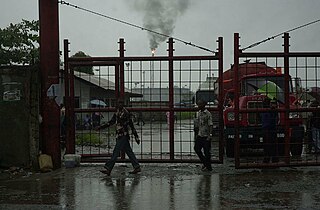
The Port Harcourt Refining Company,, is a Nigeria-based oil and gas company primarily specializing in the refining of crude oil into petroleum products. It is headquartered in Port Harcourt metropolitan area of Rivers State, southeastern Nigeria. The company is a subsidiary of the Nigerian National Petroleum Corporation (NNPC).















